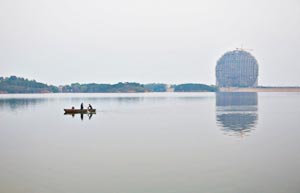

By the end of 2012, China's LNG production capacity was 23.73 million cubic meters a day. LNG prices have been rising because of a shortage of supplies, according to Sublime China Information Co Ltd, a domestic commodities consultancy.
In addition to Japan and South Korea, which are traditional LNG importers, China and India have been growing LNG imports in recent years.
According to a report from ExxonMobil Corp, the annual global LNG demand will reach 600 million metric tons, with 75 percent coming from Asia.
"Everybody is trying to add capacity to supply the Asian market, especially China," said Dale Nijoka, global oil and gas sector leader with Ernst & Young.
"Africa can be a potential supplier of natural gas," said Nijoka. "The good news is they have found natural gas in Africa, while the bad news is there is not any appropriate infrastructure there."
At present, it seems few new routes will be added to China's natural gas supply structure, said Nijoka.
According to Ernst & Young, in addition to the US LNG projects and the new possible supply from East Africa, there are several new LNG projects proposals in Canada. The traditional exporter, Australia, is witnessing significant cost escalations in its LNG sector, mostly pressured by new LNG supplies coming up.
To meet the growing demand for natural gas, the Chinese government has ambitious plans for the development of the unconventional energy source.
Many big companies including foreign ones, have shown an interest. However, experts from Ernst & Young said there are several challenges including mineral rights, controlled prices, water shortages and infrastructure.
 Aerobatic team prepare for Aviation Convention
Aerobatic team prepare for Aviation Convention
 China Suzhou Electronic Manufacturer Exposition kicks off
China Suzhou Electronic Manufacturer Exposition kicks off
 'Squid beauty' and her profitable BBQ store
'Squid beauty' and her profitable BBQ store
 A day in the life of a car model
A day in the life of a car model
 Vintage cars gather in downtown Beijing
Vintage cars gather in downtown Beijing
 Asia Bike Trade Show kicks off in Nanjing
Asia Bike Trade Show kicks off in Nanjing
 Student makes race car for 4th Formula SAE of China
Student makes race car for 4th Formula SAE of China
 Beijing suburb to hold 2014 APEC meeting
Beijing suburb to hold 2014 APEC meeting